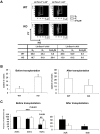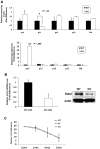Ewing sarcoma gene Ews regulates hematopoietic stem cell senescence
- PMID: 21030557
- PMCID: PMC3056469
- DOI: 10.1182/blood-2010-04-279349
Ewing sarcoma gene Ews regulates hematopoietic stem cell senescence
Abstract
The longevity of organisms is maintained by stem cells. If an organism loses the ability to maintain a balance between quiescence and differentiation in the stem/progenitor cell compartment due to aging and/or stress, this may result in death or age-associated diseases, including cancer. Ewing sarcoma is the most lethal bone tumor in young patients and arises from primitive stem cells. Here, we demonstrated that endogenous Ewing sarcoma gene (Ews) is indispensable for stem cell quiescence, and that the ablation of Ews promotes the early onset of senescence in hematopoietic stem progenitor cells. The phenotypic and functional changes in Ews-deficient stem cells were accompanied by an increase in senescence-associated β-galactosidase staining and a marked induction of p16(INK4a) compared with wild-type counterparts. With its relevance to cancer and possibly aging, EWS is likely to play a significant role in maintaining the functional capacity of stem cells and may provide further insight into the complexity of Ewing sarcoma in the context of stem cells.
Figures







Similar articles
-
Ewing sarcoma gene EWS is essential for meiosis and B lymphocyte development.J Clin Invest. 2007 May;117(5):1314-23. doi: 10.1172/JCI31222. Epub 2007 Apr 5. J Clin Invest. 2007. PMID: 17415412 Free PMC article.
-
EWS-FLI-1 regulates the neuronal repressor gene REST, which controls Ewing sarcoma growth and vascular morphology.Cancer. 2014 Feb 15;120(4):579-88. doi: 10.1002/cncr.28555. Epub 2014 Jan 10. Cancer. 2014. PMID: 24415532 Free PMC article.
-
MiR-30a-5p connects EWS-FLI1 and CD99, two major therapeutic targets in Ewing tumor.Oncogene. 2013 Aug 15;32(33):3915-21. doi: 10.1038/onc.2012.403. Oncogene. 2013. PMID: 22986530
-
EWS-ETS oncoproteins: the linchpins of Ewing tumors.Gene. 2005 Dec 19;363:1-14. doi: 10.1016/j.gene.2005.08.007. Epub 2005 Oct 3. Gene. 2005. PMID: 16202544 Review.
-
Hypoxia and HIFs in Ewing sarcoma: new perspectives on a multi-facetted relationship.Mol Cancer. 2023 Mar 13;22(1):49. doi: 10.1186/s12943-023-01750-w. Mol Cancer. 2023. PMID: 36915100 Free PMC article. Review.
Cited by
-
Integrated analysis of omics data using microRNA-target mRNA network and PPI network reveals regulation of Gnai1 function in the spinal cord of Ews/Ewsr1 KO mice.BMC Med Genomics. 2016 Aug 12;9 Suppl 1(Suppl 1):33. doi: 10.1186/s12920-016-0195-4. BMC Med Genomics. 2016. PMID: 27534535 Free PMC article.
-
An overview of the role of cancer stem cells in spine tumors with a special focus on chordoma.World J Stem Cells. 2014 Jan 26;6(1):53-64. doi: 10.4252/wjsc.v6.i1.53. World J Stem Cells. 2014. PMID: 24567788 Free PMC article. Review.
-
Role of FET proteins in neurodegenerative disorders.RNA Biol. 2016 Nov;13(11):1089-1102. doi: 10.1080/15476286.2016.1211225. Epub 2016 Jul 14. RNA Biol. 2016. PMID: 27415968 Free PMC article. Review.
-
Integration analysis of senescence-related genes to predict prognosis and immunotherapy response in soft-tissue sarcoma: evidence based on machine learning and experiments.Front Pharmacol. 2023 Jul 11;14:1229233. doi: 10.3389/fphar.2023.1229233. eCollection 2023. Front Pharmacol. 2023. PMID: 37497116 Free PMC article.
-
RummaGEO: Automatic Mining of Human and Mouse Gene Sets from GEO.bioRxiv [Preprint]. 2024 Apr 13:2024.04.09.588712. doi: 10.1101/2024.04.09.588712. bioRxiv. 2024. Update in: Patterns (N Y). 2024 Oct 11;5(10):101072. doi: 10.1016/j.patter.2024.101072. PMID: 38645198 Free PMC article. Updated. Preprint.
References
-
- Meltzer PS. Is Ewing's sarcoma a stem cell tumor? Cell Stem Cell. 2007;1(1):13–15. - PubMed
-
- Bertolotti A, Bell B, Tora L. The N-terminal domain of human TAFII68 displays transactivation and oncogenic properties. Oncogene. 1999;18(56):8000–8010. - PubMed
-
- Matsunobu T, Tanaka K, Nakamura T, et al. The possible role of EWS-Fli1 in evasion of senescence in Ewing's family tumors. Cancer Res. 2006;66(2):803–811. - PubMed
-
- Deneen B, Denny CT. Loss of p16 pathways stabilizes EWS/FLI1 expression and complements EWS/FLI1 mediated transformation. Oncogene. 2001;20(46):6731–6741. - PubMed
Publication types
MeSH terms
Substances
Grants and funding
LinkOut - more resources
Full Text Sources
Other Literature Sources
Medical
Molecular Biology Databases

